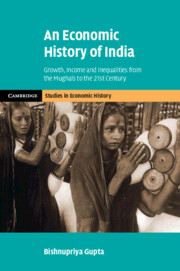Book contents
- An Economic History of India
- Cambridge Studies in Economic History
- An Economic History of India
- Copyright page
- Dedication
- Contents
- Figures
- Maps
- Tables
- Acknowledgements
- Introduction
- 1 The Decline and the Rise of the Indian Economy
- 2 Agriculture as the Engine of Growth
- 3 From Handlooms to Modern Industry and the Emergence of a Planned Economy
- 4 Origins of India’s Service Sector Advantage
- 5 Region, Income, Caste, and Gender
- 6 Colonial Development in a Comparative Perspective
- Conclusion
- References
- Index
6 - Colonial Development in a Comparative Perspective
Published online by Cambridge University Press: 06 February 2025
- An Economic History of India
- Cambridge Studies in Economic History
- An Economic History of India
- Copyright page
- Dedication
- Contents
- Figures
- Maps
- Tables
- Acknowledgements
- Introduction
- 1 The Decline and the Rise of the Indian Economy
- 2 Agriculture as the Engine of Growth
- 3 From Handlooms to Modern Industry and the Emergence of a Planned Economy
- 4 Origins of India’s Service Sector Advantage
- 5 Region, Income, Caste, and Gender
- 6 Colonial Development in a Comparative Perspective
- Conclusion
- References
- Index
Summary
Chapter 6 discusses the policies of colonization in India in a comparative perspective with Korea and Taiwan under Japanese rule. In this chapter, I consider the differences in policies of colonization. At the time of independence, the share of industry in total GDP was not very different in the three countries. Modern industries had developed in India, Korea and Taiwan during the colonial period. The two big differences in colonial policies were with respect to agriculture and education. Japan imported essential food grains from the colonies. This prompted investment in improvements in agriculture to raise productivity. A large proportion of land came under irrigation in both colonies enabling introduction of new varieties of seeds. The British government in India did little to raise agricultural productivity. Second, the Japan as a colonizer expanded primary education, helping to create a literate workforce. A large proportion of industrial workers became literate. In India as a result of the emphasis on higher education, mainly the service sector occupations benefitted in terms of human capital.
- Type
- Chapter
- Information
- An Economic History of IndiaGrowth, Income and Inequalities from the Mughals to the 21st Century, pp. 161 - 186Publisher: Cambridge University PressPrint publication year: 2025

